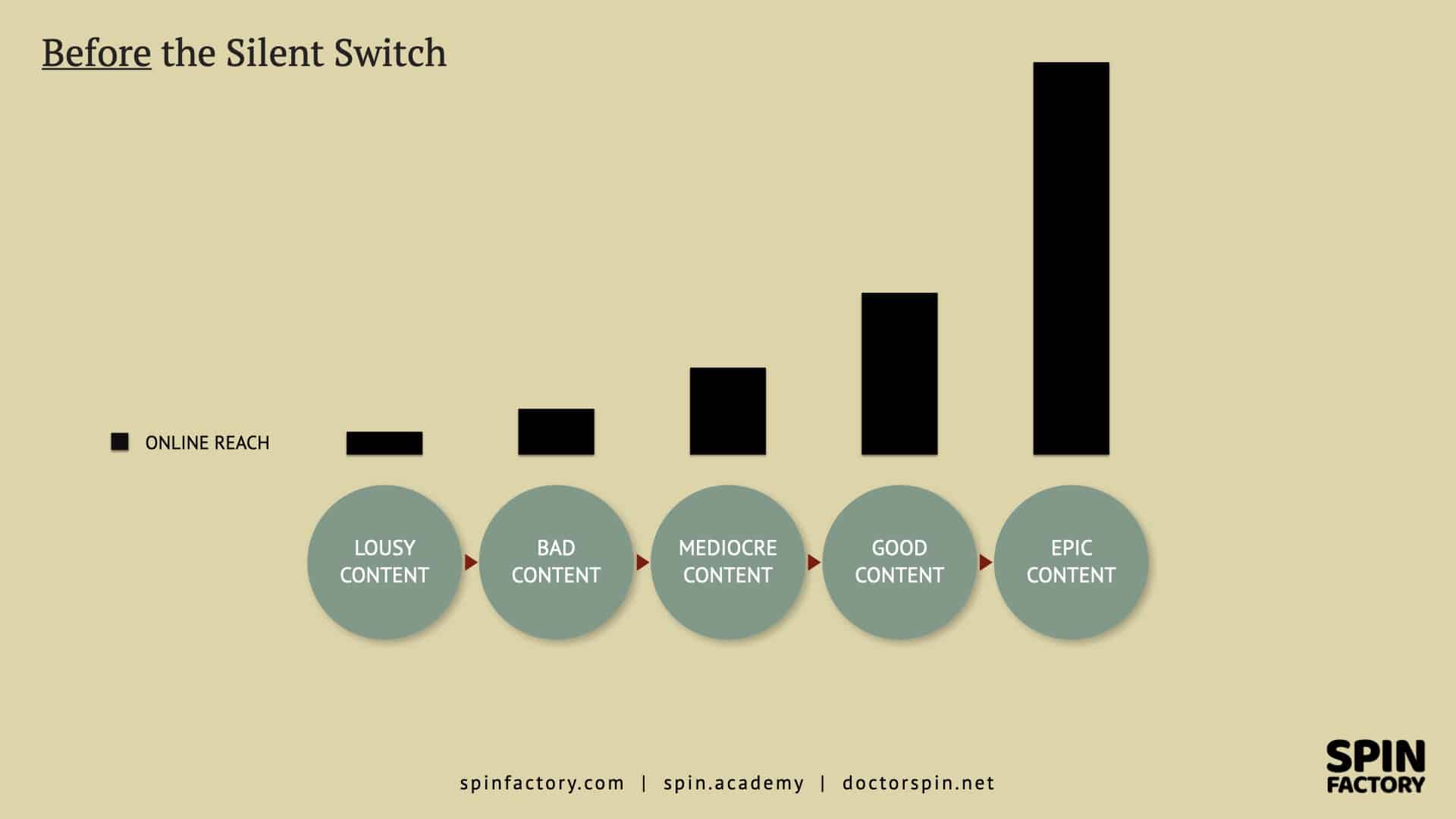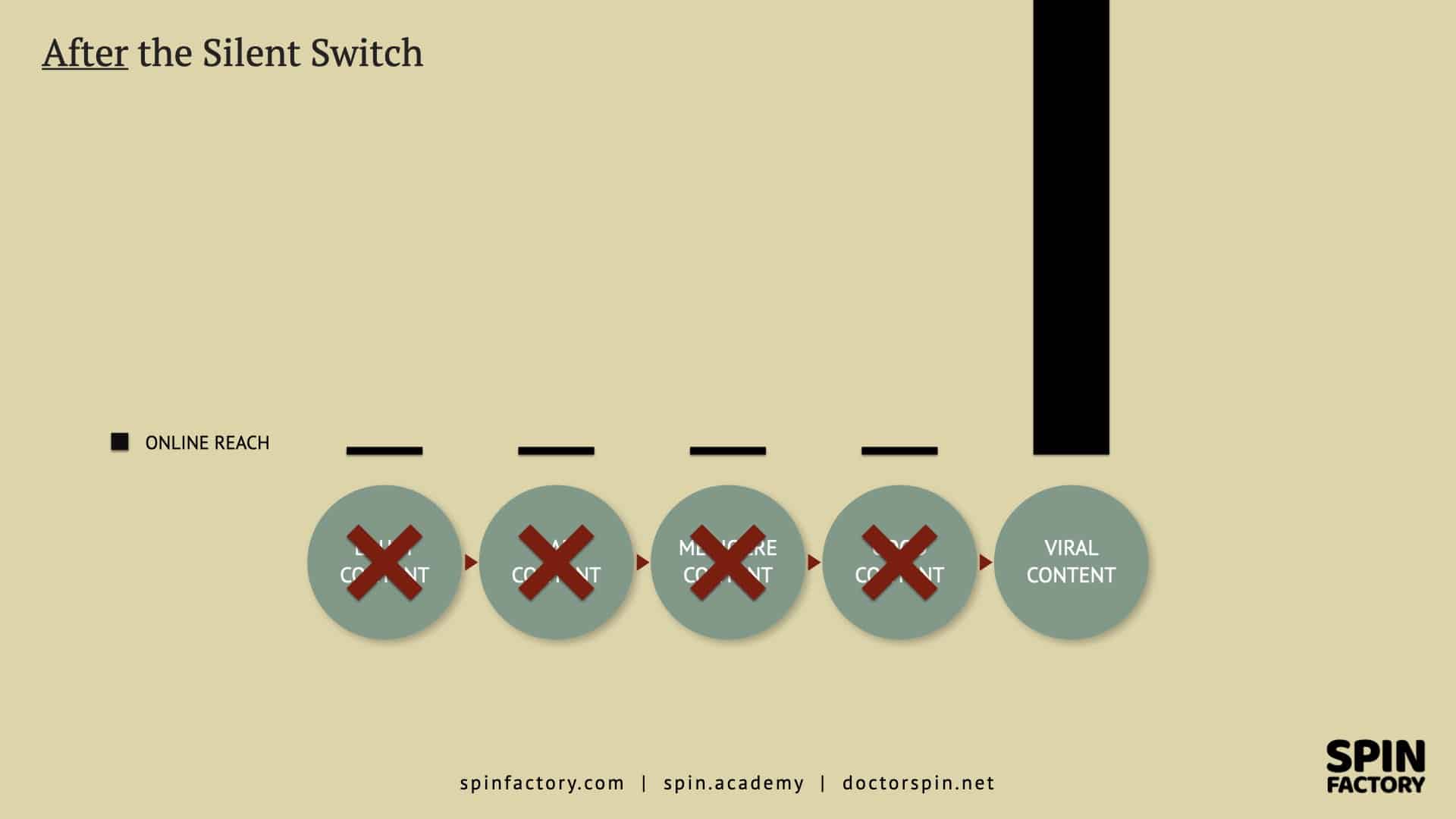Your PR campaign is probably too short.
Many organisations underestimate how long it takes for corporate messaging to propagate through a population.
Information has many opportunities to spread fast and wide throughout online social networks, but the revolution of algorithms has less to do with speed and breadth than many of us think.
Here we go:
The Glory Days of Mass Media
As mass media established dominance in the latter half of the 20th century, editorial publishing was always a weak business model. To mitigate this weakness, the mass media had to rely on various forms of advertising to enable their editorial efforts.
There’s an inherent complexity to this relationship. The mass media audience wasn’t keen on paying enough money for editorial content. Instead, they paid with another valuable form of compensation — their attention.
Of course, editorial outlets had to transform the immense value of mass attention somehow. And there was no shortage of special interests ready to pay for a slice of all that attention:
So, the audience pays for content with their attention, advertisers pay for attention with their money, and the editorial outlet pays their staff with ad revenue.
In its not-so-modest Madison Avenue beginnings, advertising had considerable strengths as a business model. Given the nature of mass media, huge audiences could be reached at any one time. It’s also reasonable to argue that traditional advertising had more prominent effects on the audience back then.
It was a great time to advertise.
And PR was allowed to piggyback.
But nothing lasts forever.
The Advent of Network Propagation
Now, most of us have some sense of how events unfolded. With the advent of the digital era, our media landscape underwent a fundamental transformation. Anyone stuck in traditional business models dependent on mass media is still struggling to find the right way to negotiate our many new online realities.
In this article, I’d like to direct your attention to such a specific change — network propagation.
The basic communication model describes a) the sender, b) the signal, c) the medium, and d) the receiver. The idea of a considerable time displacement between when the signal is sent and received is not novel; many books are read even millennia after they were first created. But this displacement has rarely been a considerable consideration.
For a long time throughout human history, the time it has taken for signals to propagate throughout a population has exponentially decreased due to ever more efficient means of mediation, from cave paintings and word-of-mouth by the campfire to global mass media conglomerates.
The Power of Signal Propagation Delay
But this is where it gets complicated. With the internet, signals were able to propagate faster than ever before. And anyone, not just mass media conglomerates, could suddenly reach global audiences at light speeds. But at this point, something had to give.
Our mental bandwidth as humans is remarkable, but not without its limits. Also, our brains haven’t exactly evolved in tandem with our means of mediation.
Although rarely discussed in such terms, the solution to the problem of limited mental bandwidth and the explosion of available signals was nothing short of a revolution. Human gatekeepers were replaced with algorithms. For whatever reason, mass media conglomerates refused to implement algorithms, leaving the playing field open to algorithm-driven tech giants like Google (now Alphabet) and Facebook (now Meta).
But this is also where the time displacement between sent and received stopped propagating exponentially. Instead, signal propagation reverted to a time of cave paintings and word-of-mouth by the campfire.
In crude terms, gatekeepers had the power to sort messages but lacked the technology to send signals at points in time determined by receivers individually. The marvel of algorithms is, contrary to popular belief, not their ability to sort signals. Their revolutionary prowess stems from their ability to delay messages throughout social graphs. 1Signal propagation delay. (2023, April 13). In Wikipedia. https://en.wikipedia.org/wiki/Signal_propagation_delay
Propagating Faster — and Slower
For a long time, signals were continuously spreading faster to larger audiences. At the algorithmic break, signals have learnt to wait patiently at nodes in a network before moving along. Today, signals can sometimes move fast, sometimes slow — and pass various socially constructed filters, allowing an often uncanny targeting precision.
Even the algorithms themselves have undergone various evolutions (such as the silent shift). But their networked nature establishes new rules for successfully propagating targeted signals.
What does the time displacement of network propagation mean for public relations and marketing? Well, for one thing — your campaigns are probably too short today.
It’s a non-sequitur to say that signals must propagate faster or slower today. A more precise way of thinking of network propagation through online social networks of algorithms is to realise that signals are getting more efficient at taking the time they need to propagate.
A Humility Check for Your PR Campaign
For corporate communications and marketing, this should be a humility check. A press release or an ad might be significant to a specific audience. In a wired world, such signals stand a good chance of reaching their recipients eventually. How long this takes will be dictated by individual needs that might not fit with ambitious corporate timelines.
The outcome is straightforward:
Most PR campaigns today are way too short. They’re created based on the sender’s needs in a media landscape where propagation is entirely dictated by the recipients’ needs.
Yes, the internet is “fast.” But relationships take time to build. It takes time to shift perceptions. Individual audience members will only process your corporate messaging if or when they need them. And our brains have limited bandwidths.
Brands must be patient and have the structural fortitude to stay consistent for their PR messaging to propagate properly and thoroughly before jumping onto the next PR campaign.
Don’t go for a huge splash tomorrow.
Go for over-the-top relevancy day-in and day-out.

Thanks for reading. Please consider sharing my public relations blog with other communication and marketing professionals. If you have questions (or want to retain my PR services), please contact me at jerry@spinfactory.com.
PR Resource: The Silent Switch
The Silent Switch
Not that long ago, social media algorithms would deliver organic reach according to a distribution that looked like this:

Today, social media algorithms deliver organic reach more like this:

It’s the Silent Switch where social networks have demoted the publisher’s authority and reputation and promoted single content performance instead.
This algorithmic change has likely had profound and severe media logic amplifications:
Classic Media Logic Effects
Media logic is hypothesised to influence the news media in the following ways: 2Nord, L., & Strömbäck, J. (2002, January). Tio dagar som skakade världen. En studie av mediernas beskrivningar av terrorattackerna mot USA och kriget i Afghanistan hösten 2001. … Continue reading
Social Media Logic Effects
Our job as PR professionals is to help organisations navigate the media landscape and communicate more efficiently — especially in times of change.
Read also: The Silent Switch: How Algorithms Have Changed
💡 Subscribe and get a free ebook on how to get better PR ideas.
PR Resource: The 7 Graphs of Algorithms
Types of Algorithm Graphs
Search engines, social networks, and online services with large user bases all have a wealth of data to design and optimise the user experience.
This data, when viewed through the lens of the seven types of graphs, forms the skeleton key to our digital identities:
The different graphs are typically weighted differently. For instance, some media companies will allow a fair degree of social graph content, while others almost none. Changes are constantly being enforced, and the Silent Switch might be the most notable example where media companies are shifting away from the social graph.
The media company can leverage these graphs using two main approaches:
Today, profiling seems to be the dominant approach amongst media companies.
Learn more: The 7 Graphs of Algorithms: You’re Not Unknown
💡 Subscribe and get a free ebook on how to get better PR ideas.
PR Resource: The Anatomy of Attention
“There’s only one thing in the world worse than being talked about, and that is not being talked about.”
— Oscar Wilde
Spin Academy | Online PR Courses
The Anatomy of Attention
Attention is an essential component of public relations:
And it’s not just organisations. We all seem to crave attention in some form or another:
“People want to be loved; failing that admired; failing that feared; failing that hated and despised. They want to evoke some sort of sentiment. The soul shudders before oblivion and seeks connection at any price.”
— Hjalmar Söderberg (1869−1941), Swedish author
It’s fear of social isolation— and attention starvation.
But what constitutes ‘attention’?
“Attention is a complex, real neural architecture (‘RNA’) model that integrates various cognitive models and brain centers to perform tasks like visual search.”
Source: Trends in cognitive sciences 3Shipp, S. (2004). The brain circuitry of attention. Trends in Cognitive Sciences, 8, 223 – 230. https://doi.org/10.1016/j.tics.2004.03.004
Each of the below terms refers to a specific aspect or type of attention (“mental bandwidth”), a complex cognitive process. 4Schweizer, K., Moosbrugger, H., & Goldhammer, F. (2005). The structure of the relationship between attention and intelligence. Intelligence, 33(6), 589 – 611. … Continue reading
Let’s explore different types of attention:
Each type of attention plays a crucial role in how we interact with and process information from our environment, and understanding these different aspects is key in fields like psychology, neuroscience, and education.
Learn more: The Anatomy of Attention
💡 Subscribe and get a free ebook on how to get better PR ideas.
ANNOTATIONS
| 1 | Signal propagation delay. (2023, April 13). In Wikipedia. https://en.wikipedia.org/wiki/Signal_propagation_delay |
|---|---|
| 2 | Nord, L., & Strömbäck, J. (2002, January). Tio dagar som skakade världen. En studie av mediernas beskrivningar av terrorattackerna mot USA och kriget i Afghanistan hösten 2001. ResearchGate; Styrelsen för psykologiskt försvar. https://www.researchgate.net/publication/271014624_Tio_dagar_som_skakade_varlden_En_studie_av_mediernas_beskrivningar_av_terrorattackerna_mot_USA_och_kriget_i_Afghanistan_hosten_2001 |
| 3 | Shipp, S. (2004). The brain circuitry of attention. Trends in Cognitive Sciences, 8, 223 – 230. https://doi.org/10.1016/j.tics.2004.03.004 |
| 4 | Schweizer, K., Moosbrugger, H., & Goldhammer, F. (2005). The structure of the relationship between attention and intelligence. Intelligence, 33(6), 589 – 611. https://doi.org/10.1016/j.intell.2005.07.001 |
























